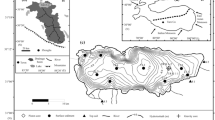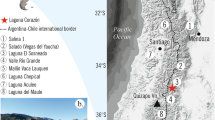Abstract
Based on modern pollen studies and reliable chronology of nine AMS 14C dates, a detailed history of vegetation and climate changes during the past 8660 cal. a BP was reconstructed by a high-resolution pollen record from Ugii Nuur in central Mongolia. Poaceae-steppe dominated the study area and the climate was mild and semi-humid before 7800 cal. a BP with a noticeable cool and humid interval at 8350-8250 cal. a BP. Xerophytic plant increased and the climate became warm and dry gradually since 7800 cal. a BP. From 6860 to 3170 cal. a BP, semi-desert steppe expanded, suggesting a prolonged warm and dry climate. Between 3170 and 2340 cal. a BP, regional forest steppe expanded whereas semi-desert steppe retreated, indicating the climate became cool and wet gradually and the humidity reached the maximum at the end of this stage. From 2340 to 1600 cal. a BP, a general cool and wet climate prevailed. And the climatic instability increased after 1600 cal. a BP. Review of regional published palaeoclimatic records implies that the mid-Holocene dry climate might have prevailed in vast areas from central Mongolia to arid areas of northwest China. Pollen-based climate reconstruction for UG04 core was well correlated with the result of climate model on Central Asia by Bush. In addition, several abrupt climatic events (cool and wet) were found and some could be broadly compared with the cool events in Atlantic.
Similar content being viewed by others
References
O’Brien S R, Mayewski P A, Meeker L D, et al. Complexity of Holocene climate as reconstructed from a Greenland ice core. Science, 1995, 270: l962–1964
Bond G, Showers W, Cheseby M, et al. A pervasive millennial-scale cycle in North Atlantic Holocene and Glacial climates. Science, 1997, 278: 1257–1266
Steig E J. Mid-Holocene climate change. Science, 1999, 286: 1485–1487
Visbeck M. The ocean’s role in Atlantic climate variability. Science, 2002, 297: 2223–2224
Lydolph P E: Climates of the Soviet Union. In: Landsberg H E, ed. World Survey of Climatology volume 7. Amsterdam: Elsevier, 1977. 7–33
Dorofeyuk N I, Tarasov P E. Vegetation and lake levels of northern Mongolia since 12500 yr BP based on the pollen and diatom records. Stratigr Geol Correl, 1998, 6: 70–83
Grunert J, Lehmkuhl F, Walther M. Paleoclimatic evolution of the Uvs Nuur basin and adjacent areas (Western Mongolia). Quat Int, 2000, 65/66: 171–192
Peck J A, Khosbayar P, Fowell S J, et al. Mid to late Holocene climate change in north central Mongolia as recorded in the sediments of Lake Telmen. Palaeogeogr Palaeoclimatol Palaeoecol, 2002, 183: 135–153
Fowell S J B, Hansen C S, Peck J A, et al. Mid to late Holocene climate evolution of the Lake Telmen Basin, North Central Mongolia, based on palynological data. Quat Res, 2003, 59: 353–363
Tarasov P E, Dorofeyuk N, Meteltseva E. Holocene vegetation and climate changes in Hoton-Nur basin, northwest Mongolia. Boreas, 2000, 29: 117–126
Harrison S P, Yu G, Tarasov P E. Late Quaternary lake-level record from northern Eurasia. Quat Res, 1996, 45: 138–159
Wang W G, Feng Z D, Lee X Q, et al. Holocene abrupt climate shifts recorded in Gun Nuur lake core, northern Mongolia. Chin Sci Bull, 2004, 49(5): 520–526
Prokopenko A A, Khursevich G K, Bezrukova X B, et al. Paleoenvironmental proxy records from Lake Hovsgol, Mongolia, and a synthesis of Holocene climate change in the Lake Baikal watershed. Quat Res, 2007, 68: 2–17
Feng Z D, Wang W G, Guo L L, et al. Lacustrine and eolian records of Holocene climate changes in the Mongolian Plateau: preliminary results. Quat Int, 2005, 136: 25–32
Feng Z D, Zhai X W, Ma Y Z, et al. Eolian environmental changes in the Northern Mongolian Plateau during the past ∼35000 yr. Palaeogeogr Palaeoclimatol Palaeoecol, 2007, 245: 505–517
Walther M. Lake bottom sediments of Ugii Nuur—Dedicated to Dr. Tserensodnom, the father of modern lake research of Mongolia. Sci J Geogr Problems, 2002, 2: 41–44
Tuvdendorzh D, Myagmarzhav B. Atlas of the Climate and Ground Water Resources in the Mongolian People’s Republic. Ulan Bator: GUGMS of Mongolia, 1985
Hilbig W. The Vegetation of Mongolia. Amsterdam: SPB Academic Publishing, 1995. 89–119
Lavrenko E M, Yunatov A A, Aleksandr A, et al. Vegetation Map of People’s Republic of Mongolia (Scale 1:1500000) (in Russian). Moscow: GUGK, 1979
Wu Y H, Wang S M, Zhou L P, et al. Modern reservoir age for 14C dating in Daihai Lake (in Chinese). Quat Sci, 2007, 27(4): 507–510
Stuiver M, Reimer P J, Braziunas T F. High-precision radiocarbon age calibration for terrestrial and marine samples. Radiocarbon, 1998, 40(3): 1127–1151
Erdtman G. Handbook of Palynology (in Chinese) (translated by the Institute of Botany, the Chinese Academy of Sciences). Beijing: Science Press, 1978
Mooer P D, Web J A. Palynology Analytical Manual (in Chinese) (translated by Li W Y, Xiao X M, Liu G X). Nanning: Guangxi People’s Publishing House, 1987
Wang F X, Qian N F, Zhang Y L, et al. Pollen Flora of China. 2nd ed. (in Chinese). Beijing: Science Press, 1995
Ma Y Z, Liu K B, Feng Z D, et al. A survey of modern pollen and vegetation along a south-north transect in Mongolia. J Biogeogr, 2008, 35: 1512–1532
Li W Y, Yao Z J. A study on the quantitative relationship between Pinus pollen in surface sample and Pinus vegetation (in Chinese). Acta Botan Sin, 1996, 38(11): 943–950
Wang F Y, Song C Q, Sun X J. Study on surface pollen in middle Inner Mongolia (in Chinese), China. Acta Botan Sin, 1996, 38(11): 902–909
Wu Y S, Xiao J Y. A preliminary study on modern pollen rain of Zabuye salt lake area, Xizang (in Chinese). Acta Botan Yunnan, 1995, 17, 1: 72–78
Gunin P D, Vostokova E A, Dorofeyuk N I, et al. Vegetation dynamics of Mongolia. In: Geobotany 26. Dordrecht: Kluwer Academic Publishers, 1999. 1–238
Liu H Y, Cui H T, Pott R, et al. The surface pollen of the woodland-steppe ecotone in southeastern Inner Mongolia, China. Rev Palaeobot Palynol, 1999, 105: 237–250
Prentice I C, Guiot J, Huntley B, et al. Reconstructing biomes from palaeoecological data: a general method and its application to European pollen data at 0 and 6 ka. Clim Dynam, 1996, 12: 185–194
Ma Y Z, Fang X M, Li J J, et al. The vegetation and climate change during Neocene and Early Quaternary in Jiuxi Basin, China. Sci China Ser D-Earth Sci, 2005, 48(5): 676–688
Sun X J, Du N Q, Weng C Y, et al. Paleovegetation and paleoenvironment of Manasi Lake, Xinjiang, N.W. China during the last 14000 years (in Chinese). Quat Sci, 1994, 3: 239–248
Liu K B, Yao Z J, Thompson L G. A pollen record of Holocene climatic changes from Dunde ice cap, Qinghai-Tibetan Plateau. Geology, 1998, 26: 135–138
Li X Q, Zhou W J, An Z S, et al. The vegetation and monsoon variations at the desert loess transition belt at Midiwan in northern China for the last 13 ka. The Holocene, 2003, 13(5): 779–784
Zhao Y, Yu Z C, Chen F H, et al. Holocene vegetation and climate history at Hurleg Lake in the Qaidam Basin, northwest China. Rev Palaeobot Palynol, 2007, 145: 275–288
Herzschuh U, Kürschner H, Ma Y Z, et al. The surface pollen and relative pollen production of the desert vegetation of the Alashan Plateau, western Inner Mongolia. Chin Sci Bull, 2003, 48(14): 1488–1493
Tarasov P E, Guinot J, Cheddadi R, et al. Climate in northern Eurasia 6000 years ago reconstructed from pollen data. Earth Planet Sci Lett, 1999, 171: 635–645
Rhodes T E, Gasse F, Lin R F, et al. A late Pleistocene-Holocene lacustrine record from Lake Manas, Zunggar (northern Xinjiang, Western China). Palaeogeogr Palaeoclimatol Palaeoecol, 1996, 120: 105–121
Chen F H, Cheng B, Zhao Y, et al. Holocene environmental change inferred from a high-resolution pollen record, Lake Zhuyeze, arid China. The Holocene, 2006, 16(5): 675–684
Zhang H C, Ma Y Z, Wünnemann B, et al. A Holocene climatic record from arid northwestern China. Palaeogeogr Palaeoclimatol Palaeoecol, 2000, 162: 389–401
Ma Y Z, Zhang H C, Pachur H J, et al. Modern pollen-based interpretations of mid-Holocene palaeoclimate (8500 to 3000 cal. BP) at the southern margin of the Tengger Desert, northwestern China. The Holocene, 2004, 14(6): 841–850
Hartmann K, Wünnemann B. Hydrological changes and Holocene climate variations in NW China, inferred from lake sediments of Juyanze palaeolake by factor analyses. Quat Int, 2009, 194: 28–44
Chen C T A, Lan H C, Lou J Y, et a1. The dry Holocene Megathermal in Inner Mongolia. Palaeogeogr Palaeoclimatol Palaeoecol, 2003, 193, 181–200
Rea D K, Leinen M. Asian aridity and the zonal westerlies: late Pleistocene and Holocene record of eolian deposition in the northwest Pacific ocean. Palaeogeogr Palaeoclimatol Palaeoecol, 1998, 66: 1–8
Chen F H, Wu W, Holmes J A, et al. A mid-Holocene drought interval as evidenced by lake desiccation in the Alashan Plateau, Inner Mongolia, China. Chin Sci Bull, 2003, 48(14): 1401–1410
Feng Z D, An C B, Wang H B. Holocene climatic and environmental changes in the arid and semi-arid areas of China: a review. The Holocene, 2006, 16(1): 1–12
An C B, Feng Z D, Barton L. Dry or humid? Mid-Holocene humidity changes in arid and semi-arid China. Quat Sci Rev, 2006, 25: 351–361
Horiuchi K, Minoura K, Hoshino K, et al. Palaeoenvironmental history of Lake Baikal during the last 23000 years. Palaeogeogr Palaeoclimatol Palaeoecol, 2000, 157: 95–108
Bush A B G. CO2/H2O and orbitally driven climate variability over Central Asia through the Holocene. Quat Int, 2005, 136: 15–23
Velichko A A, Andreev A A, Klimanov V A. Climate and vegetation dynamics in the tundra and forest zone during the late glacial and Holocene. Quat Int, 1997, 41/42: 71–96
Shi Y F, Kong Z C, Wang S M, et al. Basic features of climatic and environments during Holocene Megathemal in China. In: Shi Y F, ed. The Climates and Environments of Holocene Megathermal in China (in Chinese). Beijing: China Ocean Press, 1992. 1–18
Yang B, Wang J S, Bräuning A, et al. Late Holocene climatic and environmental changes in arid central Asia. Quat Int, 2009, 194: 68–78
Alley R B, Mayewski P A, Sowers T, et al. Holocene climatic instability: a prominent, widespread event 8200 yr ago. Geology, 1997, 25: 483–486
Wang Y J, Cheng H, Edwards R L, et al. The Holocene Asian monsoon: links to solar changes and North Atlantic climate. Science, 2005, 308: 854–857
van Geel B, Bolovenko N A, Burova N D. Climate change and the expansion of the Scythian culture after 850 BC: a hypothesis. J Archaeol Sci, 2004, 31: 1735–1742
Author information
Authors and Affiliations
Corresponding author
Additional information
Supported by National Natural Science Foundation of China (Grant Nos. 40331012, 40671190, 40421101) and U.S. National Science Foundation (Grant Nos. NSF-ESH-04-02509, NSF-BCS-06-23478, NSF-BCS00-78557)
About this article
Cite this article
Wang, W., Ma, Y., Feng, Z. et al. Vegetation and climate changes during the last 8660 cal. a BP in central Mongolia, based on a high-resolution pollen record from Lake Ugii Nuur. Chin. Sci. Bull. 54, 1579–1589 (2009). https://doi.org/10.1007/s11434-009-0023-8
Received:
Accepted:
Published:
Issue Date:
DOI: https://doi.org/10.1007/s11434-009-0023-8




